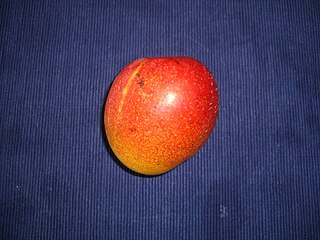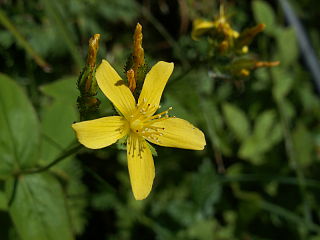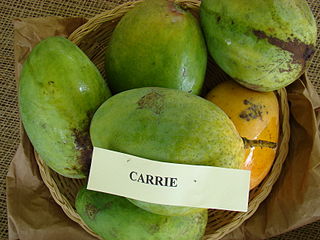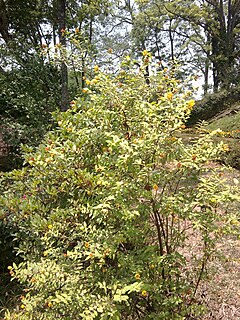
Ampelopsis, commonly known as peppervine or porcelainberry, is a genus of climbing shrubs, in the grape family Vitaceae. The name is derived from the Ancient Greek: ἅμπελος (ampelos), which means "vine". The genus was named in 1803. It is disjunctly distributed in eastern Asia and eastern North America extending to Mexico. Ampelopsis is primarily found in mountainous regions in temperate zones with some species in montane forests at mid-altitudes in subtropical to tropical regions. Ampelopsis glandulosa is a popular garden plant and an invasive weed.

Thespesia is a genus of 13 flowering shrubs and trees in the Hibiscus family, Malvaceae, although within the family they are more closely related to cotton plants (Gossypium). The genus is distributed from the South Pacific through Asia, Africa, and the Caribbean.

Xanthocercis is a tree genus in the family Fabaceae. Species include:

Germplasm are living genetic resources such as seeds or tissues that are maintained for the purpose of animal and plant breeding, preservation, and other research uses. These resources may take the form of seed collections stored in seed banks, trees growing in nurseries, animal breeding lines maintained in animal breeding programs or gene banks, etc. Germplasm collections can range from collections of wild species to elite, domesticated breeding lines that have undergone extensive human selection. Germplasm collection is important for the maintenance of biological diversity and food security.

The 'Haden' mango is a named mango cultivar that became one of the most widely cultivated in the world after it was introduced in the early 20th century through south Florida. It would ultimately become the parent of many other mango cultivars later developed in Florida.

Diosgenin, a phytosteroid sapogenin, is the product of hydrolysis by acids, strong bases, or enzymes of saponins, extracted from the tubers of Dioscorea wild yam, such as the Kokoro. The sugar-free (aglycone) product of such hydrolysis, diosgenin is used for the commercial synthesis of cortisone, pregnenolone, progesterone, and other steroid products.

The 'Keitt' mango is a late-season mango cultivar which originated in south Florida.

Hypericum montanum is a plant species in the genus Hypericum commonly known as pale St. John's-wort or mountain St. John's wort. It is native to Eurasia and Morocco in North Africa.

The 'Carrie' mango is a named mango cultivar that originated in south Florida, USA.

The 'Ford' mango is a named mango cultivar that originated in south Florida.

The 'Gary' mango is a named mango cultivar that originated in south Florida.

The 'Julie' mango, also called 'Saint Julian', is a named mango cultivar that was made popular in the Caribbean.

Hypericum cumulicola is a rare species of flowering plant in the family Hypericaceae known by the common name highlands scrub hypericum, or highlands scrub St. John's wort. It is endemic to Florida, where it is threatened by habitat loss and degradation. It is a federally listed endangered species of the United States.

The Choquette avocado is a named commercial cultivar of avocado that originated in south Florida.

Hypericum uralum is a species of flowering plant in the St. John's wort family Hypericaceae. Its native range includes China, Bhutan, India, Nepal, Pakistan and Myanmar.

Blitum is a genus of flowering plants in the amaranth family Amaranthaceae, subfamily Chenopodioideae. It is closely related to genus Spinacia. Its 12 species were traditionally placed in the genera Chenopodium, Monolepis, or Scleroblitum. The species of genus Blitum occur in Asia, Europe, North Africa, the Americas, and Australia.

Daphne blagayana is a species of plant in the genus Daphne. It was discovered in 1837 near Polhov Gradec by Heinrich Freyer and named after the botanist Rihard Blagaj.

Hypericum aegypticum, also known as Egyptian Saint John's wort, is an evergreen shrub or shrublet in the section Adenotrias of the genus Hypericum. Less frequently, dwarf Saint John's wort is used as an alternate name.
Hypericum annulatum subsp. intermedium is a subspecies of Hypericum annulatum, which is a species of the genus Hypericum. It was described by Norman Keith Bonner Robson.

Hypericum sect. Adenosepalum is one of 36 sections in the genus Hypericum. Its type species is Hypericum montanum.



















